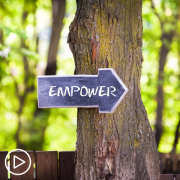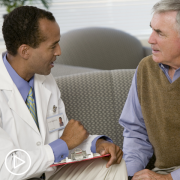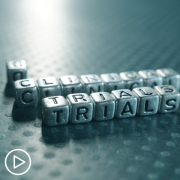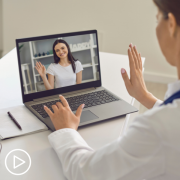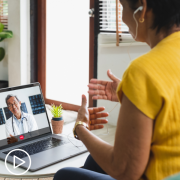Why Patients Should Speak Up About WM Symptoms and Side Effects
Why Patients Should Speak Up About WM Symptoms and Side Effects from Patient Empowerment Network on Vimeo.
Is Waldenström macroglobulinemia (WM) causing fatigue? Dr. Jorge Castillo shares why WM patients should share any symptoms and side effects they experience with their healthcare team.
Dr. Jorge Castillo is Clinical Director at the Bing Center for Waldenström Macroglobulinemia Dana-Farber Cancer Institute and Assistant Professor of Medicine at Harvard Medical School. Learn more about Dr. Castillo, here.
See More From The Pro-Active Waldenström Macroglobulinemia Patient Toolkit
Related Programs:

|

|

Factors That Affect Waldenström Macroglobulinemia Treatment Decisions |
Transcript:
Katherine:
Fatigue seems to be very common among Waldenstrom’s patients. Here’s a question that we received before the program. Kasey asks, “Why do I feel so tired all the time? Is there anything that can be done about it?
Dr. Castillo:
That’s a great question, and as I said before and basically kind of summarizing what I put together, I mean, there are many patients why a symptom with Waldenstrom’s could be fatigued. One of them is they could be anemic. The other one, they could have some hyperviscosity symptoms causing some fatigue, maybe some inflammation in the body because of the Waldenstrom’s, but maybe there are other reasons why patients can be fatigued.
And if you go out there in the streets and you start asking people, “Are you tired?” 80 percent of Americans are going to be tired. I’m not trying to minimize the symptoms of the patients. What I’m trying to say is we need to be very careful at understanding what the relation of the fatigue is with the disease. We need to be convinced that there is a relation there.
If that happened in my clinic – for example, a patient comes to see me, and they are fatigued; their hemoglobin is 14, which is normal; their IgM is about 1,000, which is not supposed to cause hyperviscosity. So, I do not know really in that context if the Waldenstrom’s is driving the fatigue or not.
Katherine:
Or if it’s something else.
Dr. Castillo:
Exactly. So, we need to make sure that the patient doesn’t have any iron deficiency, that the patient doesn’t have any thyroid problems, that the testosterone problems are okay, that there’s no sleep disturbances, that there’s no depression. So, there’s so many different other things that we need to make sure are not there before we mount into that. Because if someone is fatigued with a hemoglobin of 8, which is very low, with my treatments, if I make that 8 14, I know the fatigue is going to get better. But if the patient is fatigued with a hemoglobin of 14, which I am not going to improve with my treatments, then how confident do I feel that I’m going to improve the patient’s quality of life with a potentially dangerous treatment?
So, we talked about already secondary leukemias, neuropathy, other problems that the patient can have with the treatments or because of the treatments.
So, we need to balance that out and understand that the potential benefit has to be higher than the potential risk, and that’s why the personalization comes into play. So, fatigue is a big issue, and we try to take a very systematic approach about that, you know, ruling out other conditions, making sure that we understand its relation with the disease before recommending treatment just for fatigue.
Katherine:
Yeah. This is one side effect that is so important for patients to share with their healthcare team, right?
Dr. Castillo:
Oh, absolutely.
Katherine:
So that their healthcare team can know how to treat them.
Dr. Castillo:
That’s right. And again, there are so many interventions that are not medications that could be done in these type of situations, right? Meditation, mindfulness. There are so many other approaches to try to help in these type of situations, changing a little bit sometimes the perspective, trying to be a little bit more on the positive thinking, right?
So, there are so many different ways outside of pharmacological approaches that we can use to try to improve our patients’ quality of life.
Katherine:
Yeah. Knowing that one has an incurable disease can be very stressful, right? Knowing that you have to live with this.
Dr. Castillo:
That’s absolutely correct, and again, what I’ve seen happening in some of my patients is every little thing that happens to them, they do not know if it’s because of the disease or not.
Katherine:
Oh, yeah.
Dr. Castillo:
“So, I have a twitch there. Oh, it’s due to Waldenstrom’s. Do I need to be treated because of that twitch?” And that, I understand it. Well, I try to understand it. I’m not in that same situation, so I cannot understand it completely. But I try to understand how if you don’t trust your body anymore, right? I mean, you have a disease, and you don’t trust your body anymore, then how you trust all these little symptoms here and there?
So, in my conversations with my patients, I discuss these things openly and that you’re going to have a lot of different symptoms here and there. Most of them probably are not going to be related to the disease, but if some of them are concerning enough to you in terms of your activities, in terms of eating, drinking, sleeping, social life, sexual life, you know, working life, then let me know, and then we will be happy to investigate those because anything can happen to anybody.
So, you can have other problems. Waldenstrom’s doesn’t protect you from anything, so, and it’s always important to discuss this with patients and pay attention to the patients, not dismiss their symptoms, think about them with them, talk about them with the patients to try to understand how these are affecting them.





